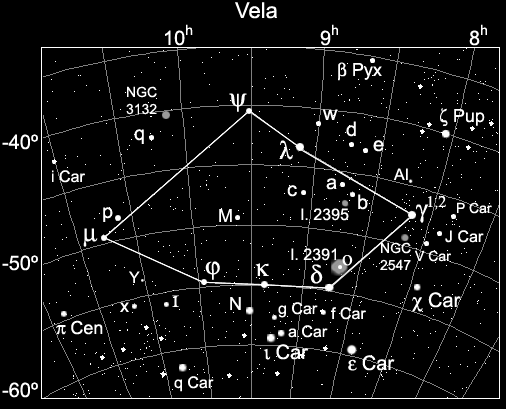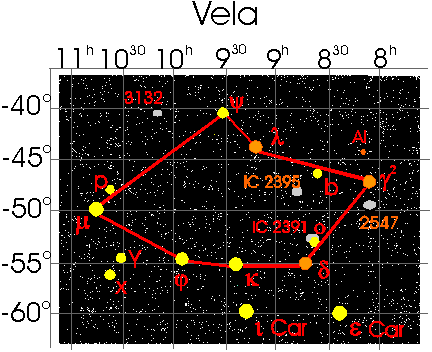
Vela, the sails of the ship Argo Navis, has a number of objects suitable for binoculars. The constellation is so far to the south that only North American residents living in the extreme southern parts of the United States (or in Central America) have a good view of the entire constellation. Residents of the Southern Hemisphere have a much clearer view; those of Sydney and Melbourne, for example, will find it high in the late winter sky as they look south. A recommended study would be Carina first.

AI Velorum is a curious variable 2.8º north-northeast of gamma Velorum, and therefore in the same field. The star is classified a pulsing variable and is the prototype of what are called dwarf Cepheids. It has an extremely short period of two hours 41 minutes, during which time it fluctuates from 6.4 to 7.1 magnitude. It oscillates with a number of frequencies, which make it one of the more popular stars for study.
Delta Velorum is a close binary. The primary is a 2.0 star, the companion 5.6. The two are 80 light years away. The region contains the bright star cluster IC 2391, about two dozen stars. Omicron Velorum, a 3.6 visual magnitude star 500 light years away, is at the centre of this cluster.
Gamma Velorum is a fine multiple binary of at least five members. The two brightest components are suitable for binoculars. The primary is gamma2, with a magnitude of 1.8 The companion, gamma1, is 4.3 magnitude, found at a position angle of 220º and 41". This companion is often listed as a true binary, that is, gravitationally bound to the primary. However the Hipparcos satellite reveals that the brighter of the two is moving at an apparent angle of 236º while gamma1 has an angle of 329º. Also, with a distance of 840 light years gamma2 is nearly half the distance of gamma1, now measured at 1600 light years. Thus they should be considered optical only. The region is at the extreme western edge of the constellation, very near Puppis. However, it is more easily found once you have studied Carina. Locate the large star cluster NGC 2516. Place this cluster at the bottom of your glasses and then move up one full FOV. Chi Carinae will be in your field. Now place this star at the bottom of your glasses and gamma Velorum will be just barely out of your FOV to the north-northwest. Gather all these stars up in your FOV. Most of them are actually in Puppis, but the brightest is gamma Velorum.
You might also start from Canopus (alpha Car) and move two complete FOVs to the east (first putting Canopus at the right edge of your glasses). That will take you to chi Carinae. Now follow the same directions as above to find gamma Velorum. The brighter star, gamma2, is a renowned star belonging to a group of very hot and luminous stars called Wolf-Rayet stars. In fact, it's the brightest member of this group, and quite possibly the most massive of this type of star. There are two objects of interest in the general field of gamma Velorum. To the south, and in the same FOV, is the star cluster NGC 2547 while to the northeast of gamma is the curious variable known as AI Velorum.
Lambda Velorum is an orange-yellow supergiant, perhaps as large as 75 times the radius of the Sun. Place gamma Vel at the right side of your FOV and move the glasses to the east one full FOV. Now move slowly to the north about a half-field of vision and lambda will slide into view on the left. Between gamma and lambda is found the cluster IC 2395.
